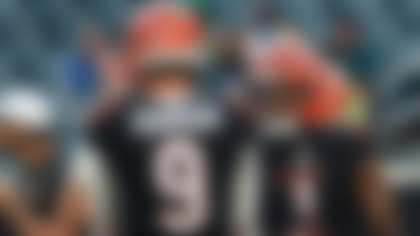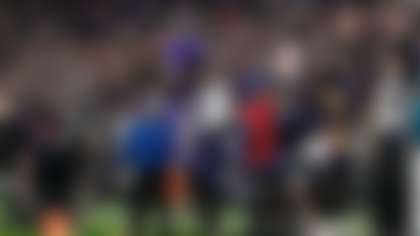NFL franchises use contextualized data to create competitive advantages. In order to realize an edge, teams need to employ the right data in the right way at the right time. This means distilling, interpreting and applying only the most influential data in a framework that accounts for personnel, opponents and evolving game situations. My goal is to be your analytics department. Each week this season, I want to work for you by giving you a peek into which numbers flag in my models as the most impactful ... or the most misunderstood.
Unfortunately, Week 2 was defined by a slew of injuries -- and to big-name players. Reigning Defensive Rookie of the Year Nick Bosa, electric playmaker Saquon Barkley and Pro Bowl receiver Courtland Sutton are all done for the season with torn ACLs. Anthony Barr, a four-time Pro Bowler at age 28, has also played his last snap of 2020, due to a torn pectoral. Meanwhile, first-team All-Pro RB Christian McCaffrey (high ankle sprain) is now on the shelf for 4-6 weeks, quarterback Drew Lock (shoulder) is facing a similar timeline for recovery, and Jimmy Garoppolo (high ankle sprain) is questionable for this week. And that's only a portion of the injuries. Just a brutally damaging week across the NFL, with all of the ailments overshadowing some fascinating football -- including a unique development at the game's most important position.
With three rushing touchdowns in the second half of Dallas' amazing comeback win over Atlanta, Dak Prescott became the first quarterback in NFL history to run for three scores while also throwing for 400-plus yards in the same game. Furthermore, Prescott, Kyler Murray and Cam Newton each have three rushing touchdowns through the first two weeks of the season. Prior to this year, that is something just three quarterbacks had accomplished in the Super Bowl era: Terry Bradshaw (in the first two weeks of the 1972 campaign), Daunte Culpepper (2000) and Rich Gannon (2000). And this isn't the only scoring-related anomaly: The league is currently averaging 50.3 combined points per game, the highest mark through two weeks of action since the 1970 merger. While these stats are fun, it remains to be seen if they are a trend or simply outliers. Kinda seems like last week's "Stat To Trust" was indeed onto something, but we'll see.
As for Week 3, you'll find my primer below, with one stat to trust, one stat to question and two sleeper players to watch. As always, let me know if your eye test is picking up on something interesting, or if there's a stat/trend you'd like me to take a deeper look at. You can hit me on Twitter @CFrelund. As with any great analytics department, the more collaborative this is, the more value we can create.
STAT TO TRUST
3.1: The percentage of rest-of-season simulations in which all four NFC West teams make the playoffs.
Don't forget that the postseason field has expanded, with a third wild-card slot added to each conference. So, yes, an entire division could make the playoffs. And two weeks into the season, no division looks better than the NFC West, which boasts a combined record of 7-1 (tops in the NFL), with the only loss being the Cardinals' intra-divisional defeat of the 49ers. This isn't much of a surprise: I projected all four of the division's teams logging eight-plus wins prior to kickoff. We all expected the NFC West to be a beast in 2020 -- and early indications suggest that it is! Which brings me to the question I'm sure many of you are asking ...
Wait, isn't 3.1 a really SMALL percentage? Why isn't it higher?
Yes, at first blush, that figure might seem small. But it's not. In fact, the NFC West's 3.1 percent is way, WAY higher than every other division. The next-highest percentage is the NFC South's 0.002. So, yeah: Respect that 3.1! Just think of everything that has to fall into place for one division to earn all three wild-card invitations. Especially considering how much you presume a strong division's teams will beat up on each other.
At this point, the NFC West is the best division in football -- and it has the best chance to pull off a sweep of the wild-card bids. With that in mind, I wanted to spotlight some key figures for each NFC West team, courtesy of Next Gen Stats:
Everyone knows about Kyler Murray's lightning-quick running speed, but how about the reigning Offensive Rookie of the Year's increasingly fast processing speed? Murray's more comfortable in Kliff Kingsbury's system in Year 2, as evidenced by how quickly he's getting the ball out. Just check out how he's improved his time to throw at every level:
Behind the line of scrimmage: 1.94 seconds, down from 2.05 in 2019.
Short (1-9 yards): 2.24 seconds, down from 2.55.
Intermediate (10-19 yards): 2.72 seconds, down from 3.06.
Deep (20+ yards): 3.35 seconds, down from 3.44.
Obviously, the offseason addition of DeAndre Hopkins -- who has the ability to separate quickly -- doesn't hurt here. But with an overall completion percentage of 66.7 (up from last year's mark of 64.4), Murray isn't sacrificing efficiency by speeding things up.

Jared Goff's play-action passes outside of the tackle box are a source of great efficiency. Two of Goff's three touchdown passes have come in this manner, with the Rams' fifth-year QB boasting a completion percentage of 90.0 (9-10), a yards-per-attempt figure of 10.1 and a passer rating of 148.3 on such throws. The big-money quarterback has been surgical in this capacity. And the team's second-highest-paid player merits attention, too ...
In Week 1 against Dallas, Aaron Donald's 10 QB pressures on 35 pass rushes netted an absurd pressure rate of 28.6 percent. Against Philadelphia this past Sunday, Donald's three pressures on 37 pass rushes resulted in an 8.1 percent mark. However, the Eagles double/triple-teamed Donald more than twice the amount of time than the Cowboys did. Basically, you have to fully commit your entire offense to stopping this force of nature -- or your quarterback will pay the price.
The injury bug bit San Francisco the hardest of all teams last Sunday. Nick Bosa wasn't the only Niners D-lineman to tear his ACL, as former No. 3 overall pick Solomon Thomas suffered the same fate. Meanwhile, QB Jimmy Garoppolo, RB Raheem Mostert and RB Tevin Coleman all sustained leg injuries of varying degrees of seriousness. All of this attrition is clouding forecasts for the Niners. Here are two things I'll be tracking specifically in the next few weeks:
1) Replacing edge defender Nick Bosa is going to be very difficult. Bosa ranks fifth in the NFL in total QB pressures (61) since entering the league in 2019. And it's very easy to see his impact when you compare San Francisco's pass rush in this span with Bosa vs. without him. In the 479 opponent dropbacks with Bosa, per Next Gen Stats, the 49ers have allowed a completion percentage of 60.6, while accumulating a pressure rate of 27.3 and a sack rate of 9.0. In the 162 dropbacks without Bosa, the completion percentage rises to 65.6, while the pressure (17.9) and sack (4.9) rates both plummet. Now imagine how much of a shift happens with layering in the impact of Thomas' season-ending injury, as well. Interesting note: The loss of Bosa shifted the Niners' rest-of-season win total down further than the loss of Saquon Barkley did to the Giants' win total. This is primarily due to the more difficult first-place schedule for San Francisco, as well as the 49ers' place in the league's toughest division.
2) San Francisco's run game is EVERYTHING -- at least until the quarterback and pass catchers are healthier. The Niners are currently best suited to play with a lead, and not be forced into heavy passing-game scripts. Through two games, San Francisco's running backs boast a +99 in RYOE (rushing yards over expected), which is the third-highest total in the NFL. Using computer vision, I can see that the pre-snap alignments and efficient O-line play (like shifts and exceptionally executed blocking schemes) really help fuel the ground attack, which is averaging 5.65 yards per carry (third in the NFL). The Niners must continue to effectively pound the rock in order to navigate around major injury blows.

Last but not least: The NFC West team that might currently look the best. My colleague, Dan Hanzus, has the Seahawks as the division's highest-rated squad in this week's Power Rankings. Hard to argue with that placement, given the way Russell Wilson has started this season.
Wilson has completed an insane 82.5 percent of his passes, racking up a 9:1 TD-to-INT ratio (with that one pick coming on a ball that went right through Greg Olsen's hands) and 140.0 passer rating. The guy's been a splash-play machine. In fact, according to NGS, on deep passes (20-plus air yards), Russ is 5 for 6 for 185 yards and four touchdowns. Wow. Wilson's majestic, high-arcing deep shots are hitting.
STAT TO QUESTION
Cam Newton leads the league in rushing TDs -- and he's running circles around Patriots running backs.
With four ground scores, Newton is currently tied for the league lead with Christian McCaffrey, but now McCaffrey's set to miss at least three games on injured reserve. And Newton's absolutely dominating the New England rushing attack, with 66 more yards and three more touchdowns than the next-leading rusher (Sony Michel, in both instances). Cam has taken 26 of the Pats' 67 total rushing attempts, averaging 4.69 yards a pop. It's also worth pointing out that Newton holds the single-season (14) and career (62) records for rushing TDs by a quarterback. But while Cam's ability to run the ball -- and keep defenses off balance due to the threat of the run -- is one of his superpowers, it's very unlikely that he'll be the Pats' leading rusher. He could be the team leader in rushing touchdowns, but he's unlikely to break his own single-season record.
This doesn't mean Newton's going to completely stop being effective on the ground. But the model the Pats have followed for many years shows that the team truly evolves over the course of a season, with substantial strategic shifts usually starting in October. I went back over the past eight years of data and identified a pattern: New England's passing identity typically begins to come into focus after the first four weeks of a season. Prior to October, the Pats show very little from a statistically significant play-calling standpoint. This approach especially makes sense this year in Foxborough, given that the Pats are breaking in a new quarterback -- one who brings a completely different playing style than his predecessor -- for the first time in two decades. And the cancellation of the preseason robbed the offense of that trial period. We saw the beginning of what is likely to be an extremely productive relationship with Julian Edelman this past Sunday (eight catches for 179 yards, but it's understandable that Newton is still largely feeling things out with his receiving corps. Not to mention, New England opened up against two teams highly susceptible to the run in Miami and Seattle, so it made plenty of sense for the Pats to lean on Newton's legs.
Let's see what happens to the Patriots' offensive approach as the season goes on, the run defenses get tougher and the passing connections become more ingrained.
TWO SLEEPER PLAYERS FOR WEEK 3

No Niners running back has been given more opportunities to carry or catch the ball in the red zone than McKinnon, with six such chances through the first two weeks of the season. And now, Tevin Coleman's expected to miss about a month, while Raheem Mostert isn't practicing due to an MCL issue. McKinnon is currently tied for third in the NFL with a +64 in RYOE (rushing yards over expected), trailing only Mostert (+71) and Cleveland's Kareem Hunt (+72), so the guy's been quite effective when given the opportunity. And with the slew of Niners injuries -- especially at QB and RB -- Kyle Shanahan's expertise at crafting an efficient rushing attack projects to be even more impactful in San Francisco's Week 3 matchup with the Giants, making McKinnon's potential even greater.

There is no replacement for Michael Thomas (high ankle sprain), but assuming his injury is something that can fully heal in relatively short order, the development of Smith's role in this offense could create an even bigger problem for opponents upon Thomas' return. Against Las Vegas on Monday night, Smith led all Saints wide receivers in catches (five) and yards (86). Next Gen Stats shows that three of those grabs and 72 of those yards came on intermediate targets (10-19 air yards). Looking forward to this Sunday night's game against Green Bay, Smith could be in line for a big game, as Adam Thielen ate up the Packers on intermediate targets in Week 1. Smith's ROI is great for fantasy this week (especially daily fantasy). And if Smith can continue to deliver once Thomas returns, the Saints will present a three-fold problem at wideout for opponents (Thomas, Smith and Emmanuel Sanders).
Follow Cynthia Frelund on Twitter@cfrelund.














